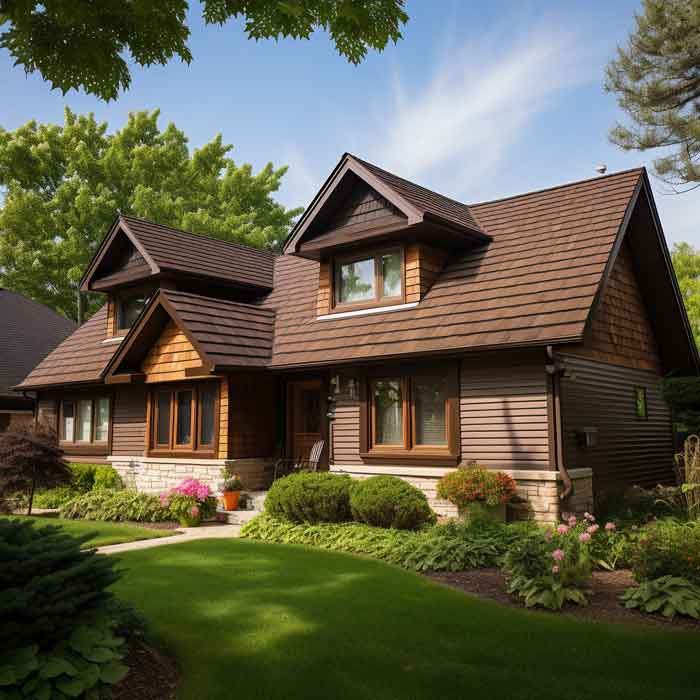Wood Shingles and Shakes: The Timeless Allure of Natural Elegance
 In the world of residential roofing, few materials evoke the warmth and charm of wood shingles and shakes. With a rich history dating back centuries, these natural roofing options continue to captivate homeowners and professionals alike. This article delves into the essence of wood shingles and shakes, exploring their composition, merits, variations in wood types, styles, installation nuances, lifespan, cost, environmental impact, fire resistance, and a glimpse of esteemed brands and product selections.
In the world of residential roofing, few materials evoke the warmth and charm of wood shingles and shakes. With a rich history dating back centuries, these natural roofing options continue to captivate homeowners and professionals alike. This article delves into the essence of wood shingles and shakes, exploring their composition, merits, variations in wood types, styles, installation nuances, lifespan, cost, environmental impact, fire resistance, and a glimpse of esteemed brands and product selections.
Description and Composition
Wood shingles and shakes are crafted from natural wood, typically cedar, redwood, or pine. Shingles are machine-cut for a precise and uniform appearance, while shakes are hand-split for a more rustic and irregular look. Their organic nature ensures a timeless appeal that harmonizes with various architectural styles.
Different Types of Wood Used
The wood used for shingles and shakes varies, with cedar and redwood being popular choices due to their natural resistance to decay and insects. Pine is also used, although it might require more frequent maintenance.
Styles and Appearances
Wood shingles are uniform and offer a clean, tailored look. Shakes, on the other hand, present a more rugged and textured appearance due to their hand-split nature. Both styles have their unique aesthetic attributes that cater to different architectural preferences.
Installation and Maintenance Considerations
Wood shingles and shakes require precise installation to ensure a watertight roof. Adequate ventilation is crucial to prevent moisture buildup. Maintenance involves regular inspections for damaged or worn-out pieces, as well as treatments to prevent decay and insect infestations.
Average Lifespan and Cost
The lifespan of wood shingles and shakes varies, with cedar and redwood roofs lasting around 30 to 50 years. Proper maintenance can extend their longevity. While wood roofing's initial cost is higher than some other options, its durability and aesthetic appeal often justify the investment.
Environmental Impact and Fire Resistance
Wood is a renewable resource, making it an environmentally friendly choice. Some wood roofing options are treated to improve fire resistance, but it's important to note that wood roofing is generally less fire-resistant than materials like metal or asphalt.
Advantages and Disadvantages
Advantages |
Disadvantages |
|
Aesthetic Appeal: Wood shingles and shakes exude a natural, rustic charm that enhances the visual appeal of any home. Insulation Properties: Wood offers inherent insulation, contributing to energy efficiency. Longevity: When properly maintained, wood roofing can last for decades. Repairability: Damaged shingles or shakes can be individually replaced, reducing overall repair costs. |
Maintenance: Regular maintenance is essential to prevent issues like rot, insect infestations, and moss growth. Higher Cost: Wood roofing tends to have a higher initial cost compared to some other materials. Fire Risk: While treatments can improve fire resistance, wood shingles and shakes are generally less fire-resistant than alternative materials. |
Popular Brands and Product Options
Reputable brands in the wood roofing industry include Cedar Impressions, Certi-label Cedar Shakes, and Maibec. These brands offer a range of styles, treatments, and finishes to cater to diverse preferences.
In conclusion, wood shingles and shakes offer more than roofing material; they offer a connection to nature's timeless elegance. From the enduring appeal of cedar to the distinct character of redwood, these materials bring warmth and charm to homes. While maintenance and fire resistance considerations exist, their visual impact and longevity often outweigh the challenges. With esteemed brands offering an array of options, homeowners can embrace the natural allure of wood while adorning their homes with a roofing choice that stands the test of time.
